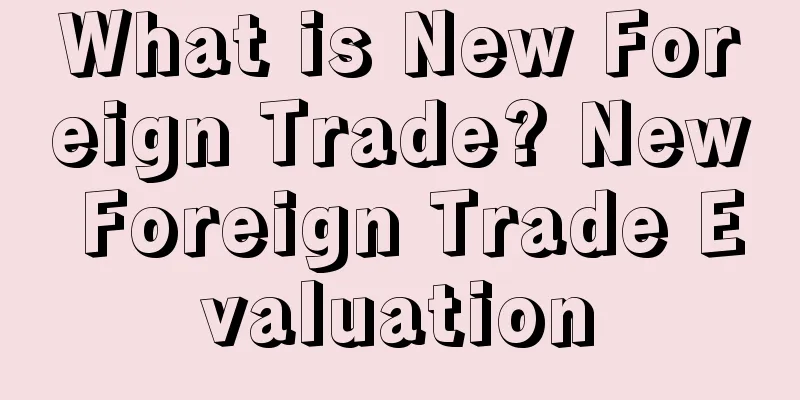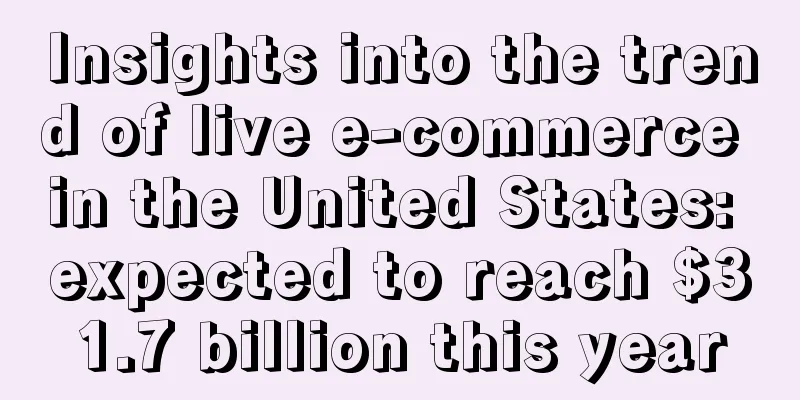What is New Foreign Trade? New Foreign Trade Evaluation

New foreign trade is redefined by data, and all aspects of foreign trade are reconstructed by data. Keywords: "big data" and new "foreign trade ecology". Proposed in 2016backgroundAffected by international political uncertainty, economic downturn, energy, exchange rate, labor costs and other factors, China's manufacturing costs have risen too fast, and China's foreign trade is entering a downturn. Specifically, exports bid farewell to double-digit growth in 2013, and the total import and export volume showed negative growth for two consecutive years in 2015 and 2016. Under this domestic and international background and situation, China's foreign trade sector has seen another "prosperous scene" - cross-border e-commerce foreign trade has continued to rise. This cross-border e-commerce foreign trade business model is often referred to by the media as the "new foreign trade e-commerce platform model" (abbreviated as "foreign trade 3.0" or "new foreign trade"). According to incomplete statistics and forecasts from the Ministry of Commerce: China's cross-border e-commerce import and export trade volume will reach 6.5 trillion yuan in 2016, and is expected to grow to 8 trillion yuan in 2017, and will maintain a growth rate of 30% in the next few years. Therefore, while the "new foreign trade" provides new strategic thinking and direction guidance for the transformation and development of China's foreign trade, it is also worth the attention of all sectors to explore its supporting new financial service content and trends. Historical development stagePhase 1 The first generation of China's foreign trade was probably from 1980 to 1990. During this era, foreign trade was all about resources, quotas and approvals. Resources were basically concentrated in the government. The most typical example was the quota system of the "Canton Fair", the core channel for traditional foreign trade exports. This system is still in use today. Therefore, in such an era, doing foreign trade well is not about core foreign trade capabilities, but about official foreign trade resources. Phase II It was probably between 1990 and 2008, which was the spring of China's foreign trade development. The strong purchasing demand, the dividends of raw materials and labor, and the policy and system dividends of foreign trade led to a large number of private foreign trade export companies springing up like mushrooms after rain and continuing to grow. Many grassroots entrepreneurs completed the successful counterattack of their companies and lives through the original accumulation of foreign trade during this period. Phase 3 From 2008 to the present, the global financial crisis that began in 2008 has caused China's foreign trade exports to be in a state of deep adjustment. China's exporting SMEs have evolved from the initial e-commerce platform "information yellow pages model" (Alibaba's early B2B model), to "platform participation in foreign trade transaction supply chain" (e-commerce platform participation in finance, logistics, foreign trade payment environment), and then to the real start of data-based in-depth transformation of China's foreign trade exports (online big data, new foreign trade ecology) New foreign trade characteristicsFirst, the new foreign trade environment The main manifestations are the international economic downturn, the rise of trade protectionism, and political instability, which bring many uncertainties to foreign trade. At the same time, the trend of supply and demand of foreign trade products tending to be miniaturized and small-order, high-frequency and fragmented, online and wireless is becoming a new feature of the international foreign trade market. Second, the new domestic environment The implementation of the national strategy of "One Belt, One Road" at the national level, the important consensus reached on the "China Initiative" for global trade inclusiveness, the "new economy" characterized by "Internet +", and the government support for "mass entrepreneurship and innovation". At the same time, the cost of China's manufacturing industry at the enterprise level has risen too fast, making it difficult to sustain the export cost advantage, and industrial transfer has also brought considerable challenges to China's foreign trade. Third, new Internet technology Mainly relying on the support of mobile Internet, big data, cloud computing and intelligence, it becomes possible to match information and complete transactions online using massive data sets. It is also more convenient for a large number of transactions to take place simultaneously on e-commerce platforms and to be completed offline through one-stop services such as logistics and finance. Fourth, new service objects and new processes This foreign trade model mainly serves small and medium-sized enterprises and provides them with one-stop comprehensive foreign trade services, including information, transactions, finance, customs clearance, logistics, foreign exchange settlement, tax refunds and other links required for import and export. On the one hand, it builds credit and reduces cross-border transaction barriers; on the other hand, it helps enterprises understand market demand in real time, guides production and research and development, and uses data to deeply analyze consumer behavior, fine-tune marketing, and reduce costs. Fifth, new thinking A typical example is the "Establishment of a World Electronic Trade Platform (eWTP) to promote public-private dialogue in the field of cross-border e-commerce" advocated by the 2016 Hangzhou G20 Summit. eWTP is known as the WTO in the field of e-commerce and trade. It intends to promote the development of e-commerce worldwide, promote trade, achieve mutual benefit and win-win results, and enhance the influence of the Chinese economy and the Chinese model in the world through dialogue and institutional cooperation between enterprises, governments, international organizations, academia, and communities, by establishing rules and strengthening cooperation. AdvantagesFirst, reduce transaction costs for small and medium-sized enterprises The development of the Internet has solved the transaction cost problem of both the supply and demand sides of foreign trade, including the cost of searching for supply and demand, the cost of matching supply and demand, negotiation cost, credit cost, customs clearance cost and logistics cost, which has greatly increased the breadth and density of foreign trade transactions. At the same time, due to the reduction of transaction costs, the income and profit deposited to the transaction parties are also increasing. Second, it provides a new ecological model for small and medium-sized service enterprises There is no incentive-aligned cooperative relationship between traditional Chinese foreign trade service enterprises and production enterprises, which is not only reflected in the incompatibility between manufacturers and middlemen, but also in the incompatibility between middlemen and other service providers such as logistics. The "New Foreign Trade" platform is to embed small and medium-sized service enterprises into a series of links in foreign trade, so that each subject can have an incentive to cooperate, and small and medium-sized service enterprises can also provide and apply their professional service capabilities in a certain field to the broad platform of "New Foreign Trade". 3. Solve the credit mechanism problem for small and medium-sized enterprises Credit has always been the most important factor in foreign trade. In the era when "Internet +" is changing traditional industries, the credit mechanism of foreign trade has also emerged in a more efficient new form. Fourth, entry barriers The core operating concept of the new foreign trade is inclusiveness, transparency, efficiency and innovation. Cross-border transactions on the Internet also mean that the entry barriers for small and medium-sized enterprises to participate in foreign trade activities are broken, and the participants can theoretically involve every corner of the world with mobile communications. References
|
<<: What is SellerGrowth? SellerGrowth Review
>>: What is Amazon Project Zero? Amazon Project Zero Review
Recommend
What is Fusionzoom? Fusionzoom Review
Fusionzoom (Ark) ERP is affiliated to Shenzhen Yin...
What is Paipai.com? Paipai.com Review
Paipai.com is a business of Tencent e-commerce tha...
What is Etsy? Etsy Review
Etsy is an online store platform that features the...
What is SEMrush? SEMrush Review
SEMrush is a powerful and comprehensive online mar...
What is BestEasy ERP? BestEasy ERP Review
Qianyi, a brand produced by Hangzhou Best Network ...
After the second sale, Shenzhen Dama’s Q3 revenue exceeded 600 million
Once upon a time, the four young masters of South ...
WOOT Promotion Annual Data Report - What do the top-selling links look like?
WOOT My C position Looking back over the past yea...
What is AImotive? AImotive Review
AImotive develops software that collects data from...
What is a global store exclusive account manager? Global store exclusive account manager evaluation
Dedicated Account Manager is a service launched by...
[On-site report] Detailed discussion of the pitfalls and opportunities of brands going overseas
Since the Amazon cocktail party last September, ma...
A Tip to Improve Amazon Product Ranking
In the competitive world of Amazon, sellers need ...
Black Friday ended perfectly! Amazon's latest update
The traditional Black Friday promotion officially...
What is Plae? Plae Review
Plae is a technology -driven children's lifest...
What is Fanpagelist? Fanpagelist Review
Fanpagelist can help users find the number of foll...
What is Yao Changjie? Yao Changjie Review
Yao Changjie, born in 1964, graduated from Shaanxi...









